#english painter
Explore tagged Tumblr posts
Text

Venus Verticordia
Artist: Dante Gabriel Rossetti (English, 1828–1882)
Date: 1864–1868
Medium: Oil on canvas
Collection: Russell-Cotes Art Gallery & Museum, Dorset, England
Description
The title of the painting refers to a quotation from the Roman poet Ovid, who describes one of Venus’ attributes as being able to assist Roman women to turn their hearts towards virtue and modesty. This does seem somewhat contradictory for such a heavily sensual and sexual image, but perhaps it is a warning of the dangers of sexual obsession.
The painting is heavy in symbolism. Venus is surrounded by flowers, the roses represent love, while the honeysuckle symbolizes sexual desire and lust. The golden fruit may be seen as the fruit that tempted Eve and led to Adam’s downfall in the Garden of Eden. Alternatively, it may be interpreted as the Apple of Discord from the Greek myth of the Judgement of Paris. In both stories, the presence of a tempting fruit in the company of a beautiful women leads to the downfall and death of men.
Venus points Cupid’s arrow at her own breast to show how she will inflict its power over others. A blue bird in the top right corner foretells doom. The moths or butterflies drawn to the light of Venus’ halo, only to perish, illustrate the brevity of life. There is a golden aura around her head, her hair is long and flaming red. A hair colouring favoured by Rossetti, the other Pre-Raphaelites and their followers. Red hair was chosen because of its rarity, and associations with excessive emotions for example sexual desire.
#painting#pre raphaelite brotherhood#venus verticordia#female figure#oil on canvas#fine art#oil painting#artwork#epic poetry#ovid's metamorphoses#literature#symbolism#flowers#roses#honeysuckle#golden fruit#cupid's arrow#blue bird#moths#butterflies#golden aura#flaming red hair#mythology#pre raphaelite movement#english culture#english art#dante gabriel rossetti#english painter#european art#19th century painting
43 notes
·
View notes
Text

Perfect Harmony, 1894
By Louis Welden Hawkins
#art#painting#fine art#classical art#english art#english artist#english painter#french art#oil painting#tempera#beauty#harmony#19th century art#european art
2K notes
·
View notes
Text

Chilvaric Love
Artist : William Dacres Adams (1864-1951)
#williiam dacres adams#english artist#english art#english painter#horse#cheval#étalon#destrier#coursier#black horse#chivalry#knight#chilvaric love#love#lady#dame#noble dame#maid#maiden
672 notes
·
View notes
Text

A Garden
Artist: Albert Moore (English, 1841–1893)
Date: 1869
Medium: OIl on Canvas
Collection: TATE Britain
Description
Albert Moore was influenced by Japanese art. He produced decorative and subtly coloured pictures. He focuses on the colour, texture and movement of draped fabric on the woman’s costume. Art critic Sidney Colvin said Moore’s subjects were ‘merely a mechanism for getting beautiful people into beautiful situations.’ Moore used the flower-like symbol at the bottom of the picture as a signature.
#oil painting#woman#albert moore#english painter#full length figure#female figure#garden#fine art#oil on canvas#costume#basket#flowers#wall#tree#english art#19th century painting#1869
242 notes
·
View notes
Text

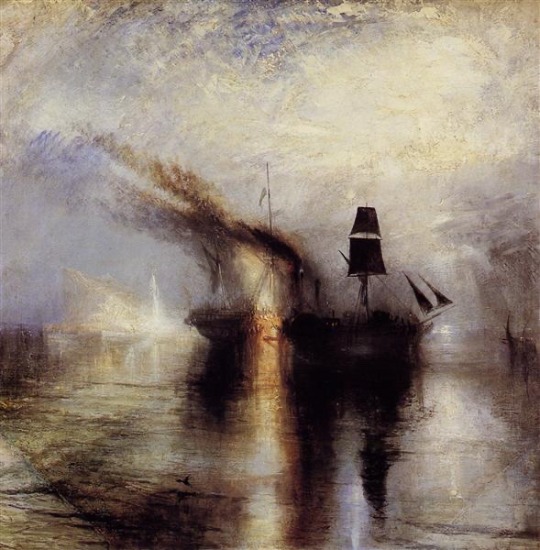
J.M.W. Turner, Snow Storm - Steamboat off a Harbour's Mouth, 1842
J.M.W. Turner, Peace - Burial at Sea, 1842
#jmw turner#english art#english artist#english painter#English painting#aesthetic#beauty#nature#landscape aesthetic#landscape art#landscape#landscape painting#english landscape#landscape painter#art aesthetic#art on tumblr#art history#aesthetictumblr#tumblraesthetic#tumblrpic#tumblrpictures#tumblr art
868 notes
·
View notes
Text

I Am Half-Sick of Shadows, Said the Lady of Shalott
Artist: John William Waterhouse (English, 1849–1917)
Date: 1915
Medium: Oil on canvas
Collection: Art Gallery of Ontario, Toronto, Ontario, Canada
Description
I Am Half-Sick of Shadows, Said the Lady of Shalott is a painting by John William Waterhouse completed in 1915. It is the third painting by Waterhouse that depicts a scene from the Tennyson poem, "The Lady of Shalott". The title of the painting is a quotation from the last two lines in the fourth and final verse of the second part of Tennyson's poem:
But in her web she still delights To weave the mirror’s magic sights, For often thro’ the silent nights A funeral, with plumes and lights And music, came from Camelot: Or when the moon was overhead Came two young lovers lately wed; 'I am half sick of shadows,' said The Lady of Shalott.
The painting shows the Lady of Shalott resting from her weaving.
The lady wears a red dress, in a room with Romanesque columns holding up the arches of the window reflected in the mirror. The frame of the loom and the geometric tiles of the floor lead the viewer into the room, where reds, yellows and blues echo the more vivid colours outside. A single poppy can be seen reflected in the mirror. The shuttles of the loom resemble boats, foreshadowing the Lady's death.
#painting#the lady of shalott#woman#english culture#english art#literature#poetry#oil on canvas#artwork#fine art#alfred tennyson#literary art#interior#full length#red dress#columns#arches#window#mirror#poppy#reflection#shuttles#weaving#loom#geometric tiles#exterior cityscape#john william waterhouse#english painter#pre raphaelite movement#pre raphaelite style
73 notes
·
View notes
Text

Le Pandemonium
(John Martin, 1841)
#paintings#art#painting#classic art#academic art#traditional media#19th century art#pandemonium#apocalyptic#john martin#english painter#pintura#louvre collections#luv вдохновляемся
152 notes
·
View notes
Photo
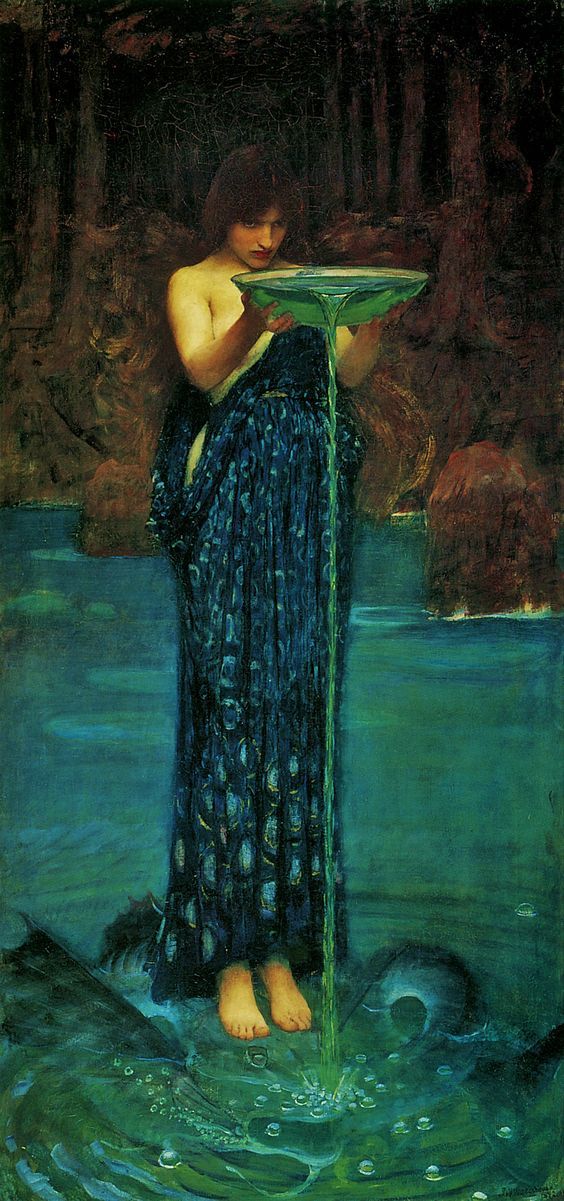
Circe Invidiosa, 1892, John William Waterhouse (1883-1917)
#circe invidiosa#john william waterhouse#pre-raphaelite#english painter#the myth of circe#mythology#mythological painting
1K notes
·
View notes
Text

Naomi and Ruth
Artist: Evelyn De Morgan (English, 1855–1919)
Date: 1887
Medium: Oil on Canvas
Naomi and Ruth
The story of Naomi appears in the Bible in the book of Ruth. Naomi lived during the time of the judges. She was the wife of a man named Elimelech, and they lived in Bethlehem with their two sons, Mahlon and Kilion. Naomi’s life illustrates the power of God to bring something good out of bitter circumstances.
When a famine hits Judea, Elimelech and Naomi and their two boys relocate to Moab (Ruth 1:1). There, Mahlon and Kilion marry two Moabite women, Orpah and Ruth. After about ten years, tragedy strikes. Elimelech dies, and both of Naomi’s sons also die, leaving Naomi, Ruth, and Orpah widows (Ruth 1:3–5). Naomi, hearing that the famine in Judea was over, decides to return home (Ruth 1:6). Orpah stays in Moab, but Ruth chooses to move to the land of Israel with Naomi. The book of Ruth is the story of Naomi and Ruth returning to Bethlehem and how Ruth married a man named Boaz and bore a son, Obed, who became the grandfather of David and the ancestor of Jesus Christ.
The name Naomi means “sweet, pleasant,” which gives us an idea of Naomi’s basic character. We see her giving her blessing to Ruth and Orpah when she tells them to return to their mothers’ homes so that they might find new husbands: she kisses them and asks that the Lord deal kindly with them (Ruth 1:8–14). But her heartache in Moab was more than Naomi could bear. When she and Ruth arrive in Bethlehem, the women of the town greet Naomi by name, but she cries, “Don’t call me Naomi... Call me Mara, because the Almighty has made my life very bitter. I went away full, but the Lord has brought me back empty. Why call me Naomi? The Lord has afflicted me; the Almighty has brought misfortune upon me” (Ruth 1:20–21). The name Mara means “bitter.” The cup of affliction is a bitter cup, but Naomi understood that the affliction came from the God who is sovereign in all things. Little did she know that from this bitter sorrow great blessings would come to her, her descendants, and the world through Jesus Christ.
Ruth meets a local landowner, Boaz, who is very kind to her. Naomi again recognizes the providence of God in providing a kinsman-redeemer for Ruth. Naomi declares that the Lord “has not stopped showing his kindness to the living and the dead" (Ruth 2:20) Seeing God’s hand in these events, Naomi encourages Ruth to go to Boaz as he slept in the threshing floor in order to request that he redeem her and her property. Naomi’s concern was for Ruth’s future, that Ruth would gain a husband and provider.
Naomi’s bitterness is turned to joy. In the end, she gains a son-in-law who would provide for both her and Ruth. She also becomes a grandmother to Ruth’s son, Obed. Then the women of Bethlehem say to Naomi, “Praise be to the Lord, who this day has not left you without a guardian-redeemer. May he become famous throughout Israel! He will renew your life and sustain you in your old age. For your daughter-in-law, who loves you and who is better to you than seven sons, has given him birth” (Ruth 4:14–15). Naomi was no longer Mara. Her life again became sweet and pleasant, blessed by God.
#naomi#ruth#landscape#women#book of ruth#old testament#christian art#christianity#bible story#emily de morgan#english painter#european#19th century painting
66 notes
·
View notes
Text
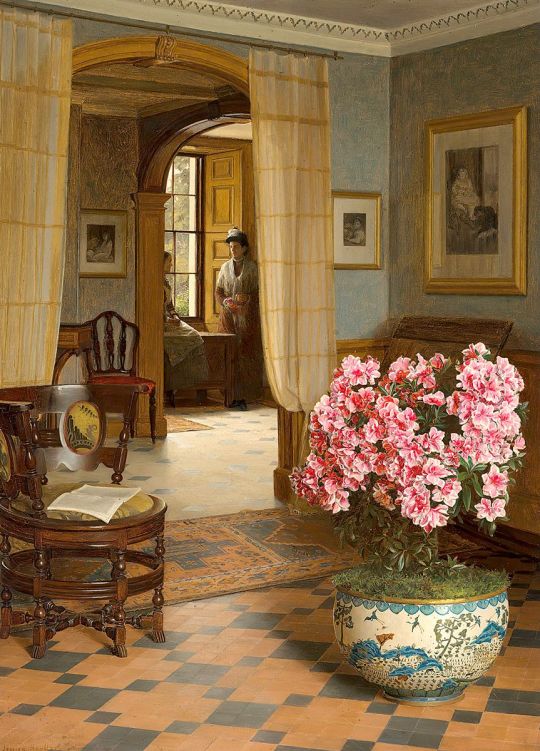
Jessica Hayllar (British/English, 1858-1940) • Fresh from the Greenhouse • 1885
#art#fine art#painting#art history#jessica hayllar#woman artist#english painter#british artist#realism#oil painting#paintings of interiors#paintings of domestic interiors#interior with figure#the painted room art blog#art blogs on tumblr#art lovers on tumblr
167 notes
·
View notes
Text

Circe Envidiosa
Artist: John William Waterhouse (English, 1849-1917)
Date: 1892
Medium: Oil on canvas
Collection: Art Gallery of South Australia, Adelaide, Australia
Description
The myth of Circe, Glaucus, and Scylla originates in Book XIV of Metamorphoses. The specific scene that Waterhouse bases this painting on occurs in lines 52–65 of the epic poem:
There was a cove, a little inlet shaped like a bent bow, a quiet place where Scylla, at midday, sought shelter when the sea and sky were hot; and, in midcourse, the sun scorched with full force, reducing shadows to a narrow thread. And Circe now contaminates this bay, polluting it with noxious poisons; there she scatters venom drawn from dreadful roots and, three-times-nine times, murmurs an obscure and tangled maze of words, a labyrinth— the magic chant that issues from her lips. Then Scylla comes; no sooner has she plunged waist-deep into the water than she sees, around her hips, the horrid barking shapes.
Waterhouse's version similarly shows Circe floating over the water in the cove, pouring bright green poison into the pool below. Under her feet, Scylla's "barking shapes" already swirl in the bubbling depths below; the transformation is well underway. Neither Scylla's human form nor her monster form is the emphasis here. Rather, the power of Circe's grave face and tangible jealousy rules this scene, as the vivid colors swirl all around her figure.
#painting#john william waterhouse#mythology#poetry#circe#cove#english culture#english art#pre raphaelite movement#art#oil on canvas#artwork#fine art#oil painting#classical mythology character#ovid's metamorphoses#emerald green gown#floating#bright green poison#swirls#english painter#19th century painting#european art
53 notes
·
View notes
Text
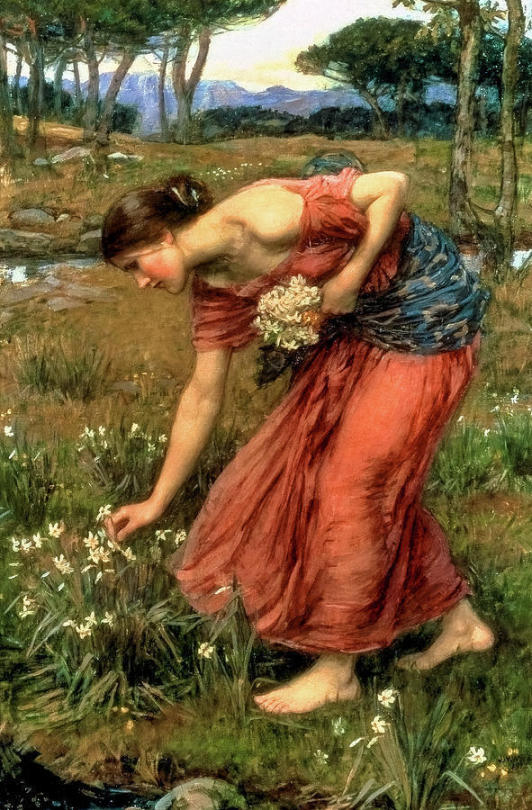
Narcissus
Artist: John William Waterhouse (English, 1849–1917)
Date: 1912
Material: Oil on canvas
Collection: Private collection
Description
John William Waterhouse is very famous for his use of the Pre-Raphaelite style. Most of his pieces express classical mythology, historical subjects, and British poetry. He is known for his great proficiency in oils and watercolors. Narcissus was exhibited at the Royal Academy in 1912.
The exquisite oil painting on canvas displays a woman picking flowers in a field. According to the Greek mythology by Ovid, Narcissus was the son of the river god Cephissus and the nymph Liriope. Narcissus had been promised to live to an old age if only he would not look at his reflection, and so he rejected all women who fell in love with him and would not look at himself. Eventually, he was subdued by Echo, a woman who was deeply hurt by his rejection that she caused the Goddess Nemesis to strike Narcissus that he may look at his reflection in a pool and fall in love with himself. Narcissus then looked at his reflection in the pool till he died.
This story gives origin to the narcissus flower, which grew where Narcissus died. The flower grows almost anywhere but prefers well-drained soil with a sunny or light shade environment. The masterpiece of oil on canvas is set in a beautiful wooded landscape, seemingly with a stream and rocky edges. Wildflowers grow there too, and a young lady is bent picking them. Her countenance is downcast in the flowers. In her other hand, she holds a bunch of already picked flowers. She is dressed in a red dress, perhaps to symbolize love or a burning passion. The flowers she is picking are the narcissus flowers. Waterhouse was always keen to use colours, patterns, and simple objects for symbols of the old mythologies. The Narcissus would be no different. This wonderful work of art brings out his genius with the oils on canvas as he seemingly brings every aspect to life as rich in meaning.
Waterhouse was much influenced and inspired by Greek Mythology and works by Homer, Ovid, Shakespeare, and Keats, among other famous writers and poets from the time. His most common theme from these sources was femme fatale, the woman who ensnares a man. Most of Waterhouse's subjects were women from Greek Mythology, historical or literary texts. Often, he used live models, family, and friends to be his subjects, creating a great mix of the old and new as he used symbolism from the mythologies around current
#painting#narcissus#classic mythology#pre raphaelite style#field#woman#picking flowers#costume#wildflowers#english painter#artwork#fine art#oil on canvas#greek mythology#water stream#trees#mountains#blue horizon#literature#ovid#narcissus flowers#john william waterhouse#english art#20th century painting#european art
429 notes
·
View notes
Text

Gwendolen Gascoyne-Cecil, 1895
By Edward Burne-Jones
#art#painting#fine art#classical art#english art#english artist#english painter#british art#british artist#british painter#beauty#portrait#female portrait#drawing#chalk art#19th century art#19th century#european art#1800s
536 notes
·
View notes
Text

Arctic Encounter
Artist : Arthur Wardle (1864-1949)
#arthur wardle#english painter#english art#english artist#bear#water nymph#sea nymph#mermaid#sirène#nymphe des eaux#sirena#white bear#ours#ours blanc#arctique#arctic#sea#ocean#mer#red hair#polar bear#ours polaire#green#vert
1K notes
·
View notes
Text

The Grey Parrot
Artist: Walter Howell Deverell (English, 1827-1854
Date: c. 1852-1853
Medium: Oil on canvas
Collection: National Gallery of Victoria, Melbourne, Australia
#painting#artwork#genre art#open book#interior scene#oil on canvas#fine art#oil painting#english culture#parrot#reading#woman#potted plant#seated#chair#curtains#costume#leisure#daily life#english painting#walter howell daverell#english painter#english art#european art#19th century painting#national gallery of victoria
98 notes
·
View notes
Text
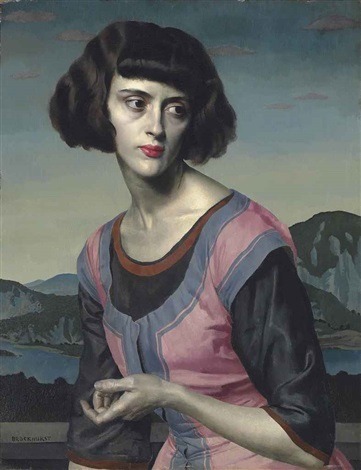
Gerald Leslie Brockhurst, Nadia, ca. 1921
#Gerald Leslie Brockhurst#portrait art#portraiture#portrait painting#portraits#british painter#british art#british artist#english art#english painting#english painter#english artist#modern art#art history#aesthetictumblr#renaissance#renaissance painting#tumblraesthetic#tumblrpic#tumblrpictures#tumblr art#aesthetic#beauty
157 notes
·
View notes